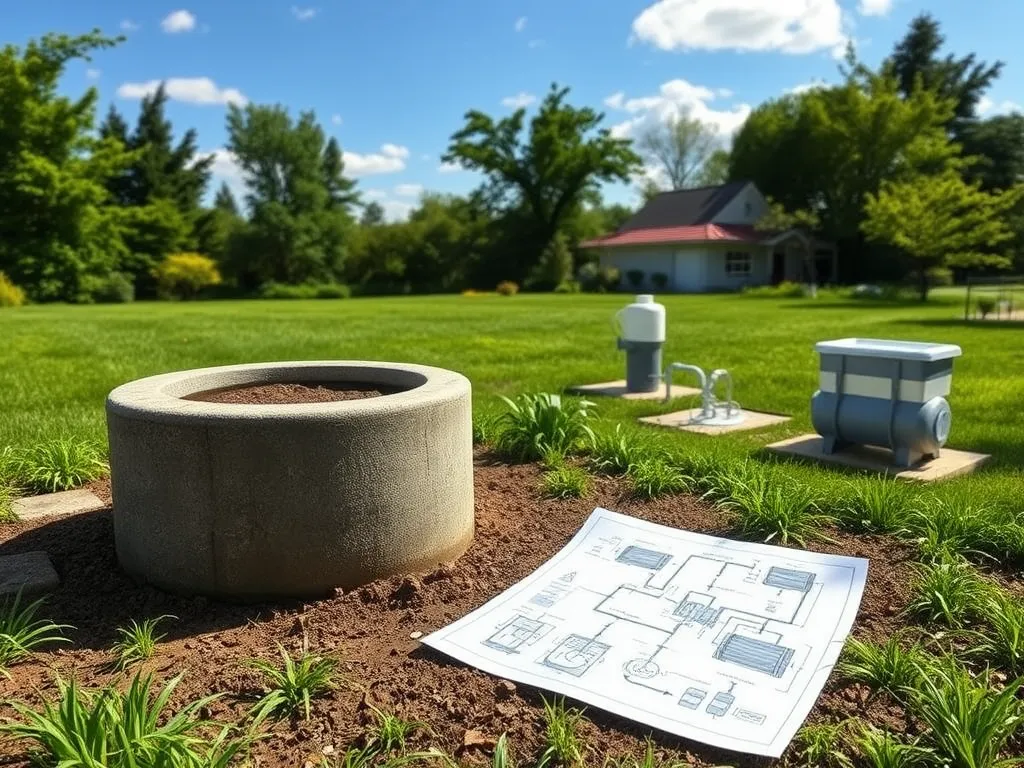Choosing the Best Septic System for Your Home

Understanding Septic Systems: A Comprehensive Guide
Septic systems are one of the most common ways of treating and disposing of wastewater in rural areas or places where public sewer systems are not available. They are often used in residential homes, commercial buildings, and even recreational vehicles. Understanding how septic systems work and the different types available is essential for homeowners and property owners. In this comprehensive guide, we will explore the different aspects of septic systems, including types, factors to consider, comparing different systems, choosing the right system, and maintenance and care.
Discover the features of the Best Septic System for your home.
Septic systems work by collecting and treating wastewater from toilets, sinks, showers, and other household drains. The system consists of a septic tank, distribution box, and drainfield. When wastewater enters the septic tank, solids settle to the bottom and form a layer of sludge, while oils and greases float to the top and create a scum layer. The liquid portion, called effluent, flows to the distribution box and then into the drainfield, where it is naturally filtered and treated by the soil.
There are several types of septic systems available, each with its own advantages and considerations. The most common type is the conventional septic system, which consists of a septic tank and drainfield. Other types include aerobic treatment units, sand mound systems, mound systems, pressure distribution systems, and alternative septic systems.
Conventional septic systems are the simplest and most common type. They are suitable for areas with good soil drainage and adequate space for a drainfield. Aerobic treatment units are advanced systems that use oxygen to enhance the treatment process. They are ideal for areas with poor soil drainage or strict environmental regulations. Sand mound systems and mound systems are designed for properties with high groundwater levels or shallow soil depths. Pressure distribution systems use a pump to evenly distribute effluent to the drainfield. Alternative septic systems include innovative technologies that may be necessary in areas with challenging soil conditions or limited space.
When considering a septic system, there are several factors to take into account. Soil conditions play a crucial role in determining the type of system that can be installed. Some soil types, such as clay or rock, may not provide adequate drainage and may require special systems. Lot size and layout are also important considerations as they dictate the available space for the septic system and drainfield. Regulatory requirements vary by jurisdiction, and it's essential to understand and comply with local regulations to avoid fines or legal issues.
Types of Septic Systems
Conventional septic systems consist of a septic tank and drainfield. The septic tank collects wastewater and separates solids from liquids. The liquid portion, or effluent, is then discharged into the drainfield, where it is naturally filtered and treated by the soil. Conventional systems are suitable for properties with good soil drainage and adequate space for a drainfield. They are relatively simple and cost-effective but may not be suitable for areas with poor soil conditions or strict environmental regulations.
Aerobic treatment units (ATUs) are advanced septic systems that use oxygen to enhance the treatment process. They typically consist of a pretreatment tank and aeration chamber. The pretreatment tank removes larger solids, while the aeration chamber promotes the growth of aerobic bacteria that break down organic matter more efficiently than in conventional systems. ATUs are ideal for properties with poor soil drainage, high groundwater levels, or stringent environmental regulations. They require electricity to operate and regular maintenance to ensure optimal performance.
Sand mound systems are designed for properties with high groundwater levels or shallow soil depths. They consist of a septic tank, pump chamber, and sand mound. The effluent is pumped from the septic tank to the pump chamber, where it is then distributed to the sand mound for further treatment. The sand mound acts as a filter, removing harmful bacteria and pathogens before the effluent percolates into the soil. Sand mound systems can be more expensive to install and require regular inspection and maintenance.
Mound systems are similar to sand mound systems and are suitable for properties with high groundwater levels or shallow soil depths. However, instead of using sand, mound systems use a mound of soil or gravel to treat the effluent. The effluent is pumped from the septic tank to the mound, where it is naturally filtered and treated. Mound systems are also more expensive to install and require regular maintenance and monitoring.
Pressure distribution systems use a pump to evenly distribute effluent to the drainfield. The septic tank collects and treats wastewater, and the effluent is then pumped to the drainfield through small diameter pipes or tubing. The pressurized distribution ensures even distribution of effluent throughout the drainfield, maximizing treatment and reducing the risk of system failure. Pressure distribution systems require electricity to operate and regular maintenance to prevent clogging or pipe damage.
Alternative septic systems include various innovative technologies that may be necessary in areas with challenging soil conditions, limited space, or strict environmental regulations. These systems can range from advanced treatment units to recycling and reusing systems. While alternative septic systems offer more flexibility and adaptability, they often require higher upfront costs and specialized maintenance.
Factors to Consider
Soil conditions play a significant role in determining the type of septic system that can be installed. Some soil types, such as clay or rock, have poor drainage properties and may require special systems like sand mound or aerobic treatment units. On the other hand, sandy or loamy soils with good drainage are suitable for conventional septic systems. A soil analysis conducted by a professional can help determine the suitability of different systems.
Lot size and layout are important considerations when choosing a septic system. The available space for the septic system and drainfield should meet local regulations and accommodate the needs of the household. Factors such as setbacks from property lines, wells, and water bodies may also influence the placement and size of the system.
Regulatory requirements for septic systems vary by jurisdiction. It is crucial to understand and comply with local regulations to avoid fines or legal issues. These regulations may specify the minimum distance between the septic system and water sources, the size of the drainfield, the type of system allowed, and the licensing requirements for installers and inspectors. Consulting with local health departments or septic system professionals can provide guidance on regulatory compliance.
Maintenance and cost considerations are essential when choosing a septic system. Regular maintenance, including inspection, pumping, and cleaning, is necessary to ensure the system functions properly and to extend its lifespan. Different systems have varying maintenance requirements, and homeowners should be prepared to invest time and money into system upkeep. Additionally, the initial installation and ongoing operating costs should be taken into account when selecting a septic system.
The environmental impact of a septic system should also be considered. Septic systems rely on the natural treatment process of soil and may have an impact on local water quality if not properly maintained or installed. Choosing an appropriate system and following best practices for maintenance can minimize the environmental impact and protect water resources.
The installation process of a septic system requires careful planning and execution. Proper site evaluation, soil testing, and system design are crucial to ensure optimal performance and longevity. Hiring septic system professionals who are licensed and experienced in installation can help avoid common pitfalls and ensure compliance with local regulations.
Comparing Different Systems
Conventional septic systems are the simplest and most cost-effective option for properties with suitable soil conditions and adequate space. They have been used for decades and are generally reliable and low-maintenance. However, they may not be suitable for areas with poor soil drainage or strict environmental regulations.
Aerobic treatment units (ATUs) offer enhanced treatment capabilities and are ideal for properties with poor soil drainage or stringent environmental regulations. They require electricity to operate and regular maintenance. While ATUs can be more expensive upfront, they provide a higher level of treatment and reduce the risk of contaminating groundwater.
Sand mound systems and mound systems are designed for properties with high groundwater levels or shallow soil depths. Both systems require additional components, such as sand or a mound of soil, to ensure proper treatment of effluent. Sand mound systems are typically used when the soil is unable to adequately filter wastewater, while mound systems are suitable for sites with limited space.
Pressure distribution systems use a pump to evenly distribute effluent to the drainfield, leading to efficient treatment and higher longevity of the system. These systems are suitable for properties with slope or soil limitations that prevent gravity flow. However, they require regular maintenance to prevent clogging or pipe damage.
Alternative septic systems provide innovative solutions for properties with challenging soil conditions, limited space, or strict environmental regulations. They can include advanced treatment units, constructed wetlands, and other alternative technologies. While these systems offer more flexibility, they often come with higher upfront costs and specialized maintenance requirements.
Choosing the Right System
When choosing a septic system, it is important to assess your needs and budget. Consider the number of individuals in your household, the amount of wastewater generated, and your budget constraints. This will help determine the size and type of system that is appropriate for your property.
Studying local regulations is crucial to ensure compliance with septic system requirements. Research the setbacks, drainfield size, and other regulations specific to your area. Local health departments or septic system professionals can provide guidance and assistance in understanding the regulations.
Consulting with septic system professionals is highly recommended before making a final decision. They can assess your property, soil conditions, and other factors to recommend the most suitable septic system. They can also provide valuable insights into local regulations and maintenance requirements.
Consider future expansion when selecting a septic system. If you anticipate changes in your household size or usage, it is important to choose a system that can accommodate potential expansions. This can save you from the hassle and cost of upgrading or replacing the system in the future.
Evaluate the environmental impact of the septic system. Choose a system and design that minimizes the risk of contaminating groundwater or surface water. Consider factors such as setbacks from wells or water bodies, proper maintenance practices, and the use of environmentally friendly components.
Maintenance and Care
Regular pumping and cleaning of the septic tank are necessary to prevent solids from accumulating and clogging the drainfield. The frequency of pumping depends on the size of the tank and the household usage. A professional septic system service provider can determine the appropriate pumping schedule for your system.
Avoid flushing harmful substances down the drain, such as grease, chemicals, medications, and non-biodegradable materials. These substances can disrupt the natural treatment process and cause system failure. Use environmentally friendly cleaning products and dispose of hazardous materials properly.
Monitor the performance of your septic system by observing any signs of problems. Slow drains, foul odors, sewage backups, or wet areas in the drainfield could indicate issues with the system. Prompt action and professional inspection can prevent further damage and costly repairs.
Learn to identify signs of septic system problems, such as gurgling sounds in the plumbing, persistent sewage odors, or wet areas around the septic tank or drainfield. Ignoring these signs can lead to system failure and potential health risks. Early detection and maintenance can prevent major damage.
Hire professionals for regular inspections of your septic system. They can assess the condition of the tank, check for leaks or damage, and ensure the system is functioning properly. Regular inspections help identify potential issues before they escalate into expensive repairs or replacements.
